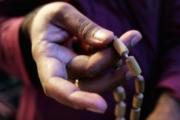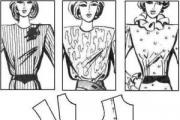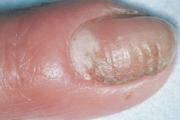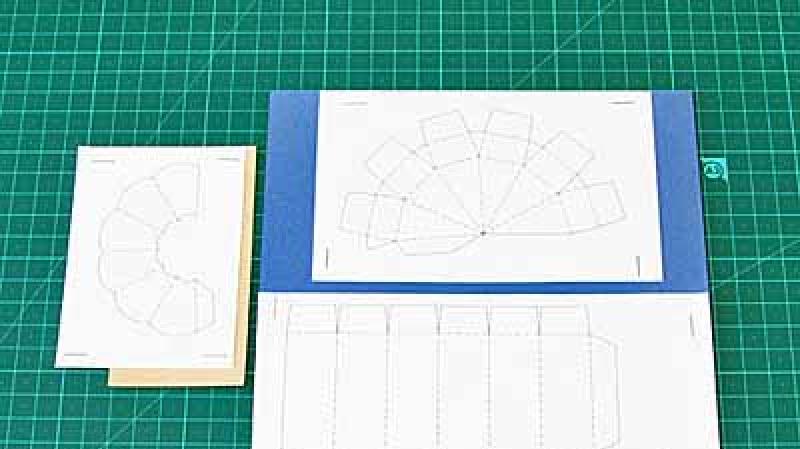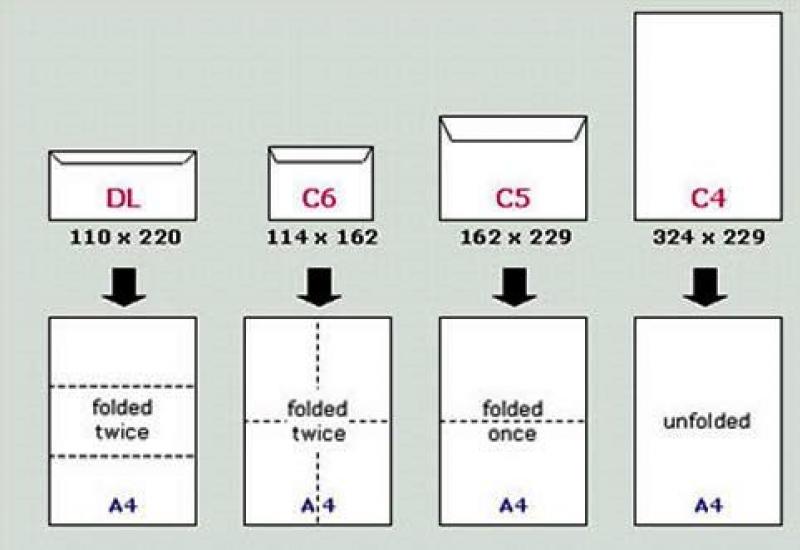Modeling the chest dart and back shoulder dart: modeling the basic dress pattern. Transferring the chest dart to the side seam Transferring the chest dart to the waist
A tuck is a constructive technique with the help of which a three-dimensional shape of a product is achieved and a uniform fit of a flat material of a complex body configuration is achieved. The main structural darts on the product correspond to certain convex areas of the figure. The upper dart of the shelf reveals the volume of the mammary gland and is located from the edge of the part towards the protruding point of the chest (determined on the pattern by the measurements Cg and Bg). The dart from the waist up on the front pattern is also directed to the same point. The chest dart is always directed to the center of the chest and can be moved to the armhole, side cut, mid-front line, waist, neckline, and can be replaced with tucks and gathers. To develop the design of models of complex shapes, they usually use a basic bodice base with set-in sleeves, in which darts are located from the shoulder sections of the back and front, from the side sections and from the waist line.
Transferring the bust dart to the waistline.
To move the chest dart to the waist line, mark its new position, then cut the pattern along this line and, having closed (laid) the main dart, open it in a new place (Fig. 1).  Fig.1. To achieve smoothness when processing a bulge on the chest, the dart should not reach the center of the chest by 1-2cm. The dart can be sewn in completely or partially, leaving softness under the bust line. Instead of a dart along the cut of the waistline, you can design an gather. In this case, the bodice is usually lengthened by 3-5 cm to create an overlap. A soft, voluminous bodice is recommended for figures who need to hide excessive thinness. A wide tuck opening can be distributed into several shallow folds - tucks.
Fig.1. To achieve smoothness when processing a bulge on the chest, the dart should not reach the center of the chest by 1-2cm. The dart can be sewn in completely or partially, leaving softness under the bust line. Instead of a dart along the cut of the waistline, you can design an gather. In this case, the bodice is usually lengthened by 3-5 cm to create an overlap. A soft, voluminous bodice is recommended for figures who need to hide excessive thinness. A wide tuck opening can be distributed into several shallow folds - tucks.
Moving the chest dart to the side cut.
To do this, draw the line of the intended dart on the front part from the side cut to the center of the chest and cut along the intended line. The chest dart from the shoulder seam is closed by aligning the cuts (Fig. 2, a).
 Fig.2.
Fig.2.
The dart obtained in this way, to achieve smoothness during processing, is not brought to the center of the chest by 3-4 cm. Using the line drawn from the side cut, you can model a cut flank, the contours of which form a rectangular relief line running through the center of the chest from the side cut to the waist line (Fig. 2, b). The vertical part of the relief is led along the dart of the waist line. The relief is decorated with decorative stitching and piping for expressiveness. If the product is made of striped or checkered fabric, the barrel can be cut at an angle of 45° to the warp thread.
Moving the dart to the neckline.
The dart into the neckline is designed in the same way as darts from the armhole, from the side cut, etc., i.e., the desired direction of the new dart is outlined, cut, closing the dart from the shoulder seam.

Fig.3. In this case, the chest dart is distributed between the dart from the side cut and from the neck. The waistline is formed by gathering (Fig. 3). The open dart from the neckline is connected to the dart from the armhole, and the upper side part of the bodice is cut off. The resulting relief can be decorated with decorative stitching, piping, lace, finishing buttons, snaps, and embroidery on the cutting part. The neckline dart can be replaced by two opposing folds located in front at its center. The drawing is developed according to the same rules for moving the dart into the neck. In this case, determine the position of the counter fold on the neckline, for which 2.5 cm is set aside from the mid-front line along the neckline. Draw a cutting line from the neck line to the center of the chest, cut it, chopping off the chest dart from the shoulder section with pins (Fig. 4).
 Fig.4.
Fig.4.
The resulting pattern for the front (front) of the bodice is transferred to paper again, marking an opposite fold in the dart solution. The neck line is marked and cut with the fold closed to obtain an accurate cut. The finished pattern is traced onto the fabric, adding seam allowances. The neckline is marked and cut only when the darts are inserted. The resulting configuration is reproduced on the fabric by adding seam allowances along the sections. Finished darts can be stitched from the reverse side, stitched along the front side of the product completely or partially, leaving a soft shape above the bust line. Instead of darts, the neckline can be decorated with gathering.
 Fig.5.
Fig.5.
Moving the chest dart into soft folds at the widened neckline.
This cut can be used for dresses and blouses made of light silk or cotton fabric. Instead of folds, the neckline is also decorated with ruffles. The model is suitable for young and slender people. To make a pattern on the basic basis of a bodice with set-in sleeves, mark a new neck line. Next, from the line of the middle front on the widened neck, lay two 3 cm. The resulting points (and the central point of the neck) are connected by straight lines to the center of the chest (Fig. 6, a).
 Fig.6.
Fig.6.
On the side cut line, set aside 3 cm from the armhole and draw a straight line from this point to the center of the chest. Clip off the chest dart and cut the pattern along the marked lines. The tuck solution is distributed evenly into the folds (Fig. 6, b).
Replacing the chest dart with puffs or pleats from the shoulder section.
The locations of the folds are marked on the shoulder cut line. The position of the first fold is 4-4.5 cm from the neckline. Then the chest line is drawn on the pattern. The position of the folds is also noted on it: for two folds, 2.5 cm are set aside from the center of the dart to the right, for three - 2.5-4 cm to the left and right. The shoulder cut points are connected to the resulting points along the chest line. The chest dart solution is distributed into the number of folds provided for by the model (Fig. 7).
 Fig.7.
Fig.7.
The folds may be soft or partially stitched. This cut is recommended for smaller busted figures to create the desired volume. In this case, folds can be replaced by gathering and puffs. For figures with large breasts, this cut (with partially stitched folds) can also be recommended, but with the aim of hiding excessive volume
Replacing a bust dart with a fold at the armhole line.
Mark a fold line parallel to the armhole to the level of the chest line and then from the armhole to the center the line of the bust dart. The pattern is cut along the marked lines, simultaneously closing the chest dart. The shoulder cut is made with the resulting fold closed at the armhole (Fig. 8).
 Fig.8.
Fig.8.
The edge of the fold can run at a distance of 1-2cm from the armhole or exactly along the armhole line. In this case, a seam allowance is added to the pattern along the armhole, and a cut is made along the intended seam for setting in the sleeve. Folds at the armhole are usually made in straight, free-form products. If the dress has a cut-off waistline, then gathers or soft folds can be placed along the shoulder section of the bodice.
Moving the bodice darts to the mid-front line.
On the bodice of the base, mark the desired direction of the dart. To do this, draw a straight line from a point located 1-2 cm below the chest line to the mid-front line at an angle. The centers of the chest and waist darts are connected. The bodice is cut along the marked lines, aligning and pinning the warp darts. The resulting tuck solution is laid towards the waist line and in this form the line of the middle front is aligned (Fig. 9).

This bodice cut is interesting for making products from striped fabrics. The mid-front line is placed on the fabric along the grain thread (and therefore along the strip). And after the dart is ground off, the strip lies on the product at an angle, along the line of the dart, connecting along the line of the middle front of the bodice in a herringbone pattern. The direction angle of the dart depends on the size of the mammary glands and the size of the waist. Therefore, when developing a bodice pattern, the direction of the dart can be found using a dummy method by pinning a fabric or paper pattern, marked with a strip, onto the figure.
Moving the bust dart to the undercut from the armhole.
At the level of 1/3 of the height of the armhole, a cutting line is marked on the base pattern. The length of the undercut should not reach 1cm from the width of the neckline. Cut the front along the intended line and close the chest dart above the undercut line, after which the dart from the armhole side will open, and the lower edge of the undercut will lengthen to form gathers (Fig. 10).
 Fig. 10.
Fig. 10.
To get more gathers on the shelf, you can cut the pattern from the hem down and spread it apart on the fabric to the desired amount. Using the same principle, you can make a pattern with any shape of undercut. The location of the undercut (above or below) is determined on the figure, observing the general proportions of the product. When moving the shelf from the undercut to the side, folds can be designed in this area (Fig. 11).
 Fig. 11.
Fig. 11.
Changing the silhouette of a product by transferring darts.
By moving the darts, you can change the shape and silhouette of the product. So, when transferring the shoulder dart to the waist or hip line, we get a pattern for a product with a flared silhouette (Fig. 9).
 Fig. 12.
Fig. 12.
When creating a flared pattern in this way, along the side seam line you need to give an allowance in the amount of 1/2-1/4 of the allowance obtained as a result of transferring the dart.
The length of the darts is determined depending on the shape of the convexity, but it is always less than the distance from the contour of the part to the center of movement. The upper (chest) dart of the front is made 2-3 cm shorter than the distance from the shoulder to the center of the chest. The back shoulder dart is usually 7-9cm long. The length and shape of the darts are specified during fitting.
If your chest height differs from that shown in the Burda table, you need to move the dart up or down by this difference.
Side or chest darts
For darts coming from the side seam, the pattern changes as follows: draw an auxiliary dotted line parallel to the mid-front line so that it passes through the top of the dart. Mark the new bust point according to the difference above or below the top of the dart.Then draw a new dart exactly parallel to the old one or

Towards this point.

To make the side seam go back to the dart, glue a strip of paper under the cut and pin a new dart. Once you have drawn a new side seam line, cut the pattern along that line and lay out the dart again.
Vertical or waist darts

Such darts are shortened or lengthened by the appropriate amount.
: Master Class
Shifting the chest point in patterns with raised seams
Also, for models with raised seams, you can move the chest point up or down. To do this, draw auxiliary lines on the details of the paper pattern at right angles to the mid-front line, respectively, in the direction of the grain thread: on the middle part of the front, approx. 10 cm above the waist, on the side front approx. 10 cm above the waist.If the chest point needs to be moved upward, then shorten the middle part of the front along the upper auxiliary line by the appropriate amount. Then add to the middle and side front the amount by which you shortened the middle front at the top.

To prevent the armhole lines from changing, cut the side front part deeper by the appropriate amount.

Changes are made exactly in mirror image if the chest point needs to be moved down.
in the product
Important
Before re-taking the paper pattern pieces, compare your measurements with the measurements given in the size table, and then adjust the paper pattern pieces by moving their parts by as many centimeters as your measurements differ from the table measurements.Source and photo: website
Material prepared by Yulia Dekanova
My teaching activity makes me think, doubt and look for the best ways to explain: how to build this or that node. Not all methods give equally successful results for different types of figures.
And at the same time, there is no point in looking for the most accurate and successful one. The very formulation of the question is amateurish. I try to explain and show with examples: all methods are good when you understand the design principle. And at the same time, none is ideal.
Let's look at the construction of the “dart solution for the bulge of the chest” knot in women's basic shoulder designs.
I recorded a short video tutorial for you with explanations and an “explanatory note” in the form of this article.
How the chest dart solution is determined in different design methods.
The complexity of this node is due to the fact that it is not possible to measure a physical indicator on the body in a direct way. Sometimes, in the author's methods, attempts are made to determine it indirectly, but it turns out only approximately. There are no reference points!
And I tell students that patterning a basic base is easy: “measure and draw.” In fact. This is how it is in all methods, but taking into account the nuances.
If you study more than one or two design techniques, you will be surprised at how similar they are to each other in basic principles: constructing a drawing grid and limiting construction areas to verticals and horizontals.
But it is surprising how differently the dart for the bulge of the chest looks and is calculated. It can be built from the line of the middle of the shelf (EMKO SEV), from the armhole (Zlachevskaya G.M.), but the most common option is to locate the dart from the shoulder cut. The top of the dart is always directed towards the center of the chest (CG, VG, VTG - different names for one point).
building a basic framework according to Zlachevskaya
 building a basic framework for EMKO SEV
building a basic framework for EMKO SEV
For example, in the method of G.M. Zlachevskaya uses two measurements of chest width: 1) along the convex part of the chest and 2) above the chest. If you correctly took the SHG and SHG control measurements, then the pattern will turn out to be quite accurate.
In the “Müller and Son” method, the algorithm for constructing a chest dart uses a formula that takes into account the circumference of the chest, but does not take into account the fullness of the chest.
1/10 POG (half chest circumference third). And often the solution turns out to be insufficient. Individual fit has to be adjusted: add 1-2 cm to the calculation formula.
A more complex path and more accurate construction is described in the EMKO TsOTSHL method. Two measurements of chest circumference are involved in the calculations: SG 1 and SG 2.

The depth of the dart is determined by the formula
2 (SG2-SG1) + 2 cm
Yes. The EMKO TsOTSHL technique is more accurate, but it is also more complex. More complex measurements, more reservations, tabular additions and conditions when constructing knots.
 construction of a dart using the TsOTSHL method
construction of a dart using the TsOTSHL method
 constructing a dart using the Muller and Son method
constructing a dart using the Muller and Son method
The technique of the French designer Lin Jacques found fans due to its simplicity of explanation and construction. There are no complicated measurements or formulas here. Take the tuck depth from the plate according to the exhaust gas measurements. Or rather, determine approximately in the interval between the OG indicators of your size (here the “range” between the measurements is as much as 10 cm).
Literally in the book it is written as follows: “The opening of the chest dart cannot be determined by measuring on the figure or by a simple proportional calculation based on number of measurements. This value is taken based on the exhaust gas.
In addition, the depth of the dart is adjusted depending on the posture.
If the shoulders are tilted back and the chest protrudes forward, then the size is increased by 1-2 cm
if the shoulders are tilted forward and the chest width is small, then the size should be reduced by 1-2 cm.”
 chest dart solution according to Lin Jacques method
chest dart solution according to Lin Jacques method
 building a basic framework according to Lin Jacques
building a basic framework according to Lin Jacques
The English method of Winfred Aldrich solves the problem of finding the chest dart solution in a very similar way. The chest dart solution is determined by the tabular method. The data in the table looks very plausible for standard figures. Overall, this is a very good, solid and uncomplicated technique for beginners. For figures with peculiarities of posture, you should take real rather than standard measurements.
 building a basic framework according to W. Aldrich
building a basic framework according to W. Aldrich
 chest dart solution according to the English method
chest dart solution according to the English method
I cannot consider all the diversity of the world of design in a short article. I touched upon only the most popular techniques in the former CIS, translated into Russian.
And for dessert - Chinese design techniques, completely unusual for us.
Practicing designers in China use a small number of dimensional characteristics and calculated proportional construction.
The constructions are simple. First, a base is built without darts, and only then darts are applied to the base base.
Many Chinese methods use the principle of a right triangle, in which one of the legs is always equal to 15 cm, and the second leg is a floating value X. This value is determined by calculation method depending on the construction unit.
To determine the X value when constructing a chest dart:
(OG 3 – OG 5) / 2
Og 3 is the chest circumference at the convex points, recorded in full size. Dimensional feature Og5 measured immediately after measurement Og3 , placing the measuring tape on the back in the same place, and in front lowering it lower, under the base of the mammary glands.
Wondering about the attitude ( 15: X ) , you can build a dart on any site
shelves, directing it to the side, neckline, armhole, shoulder, side or waist sections.
 building a basic framework using Chinese methods
building a basic framework using Chinese methods

 comparison of tuck depth using different methods with the same physical indicators.
comparison of tuck depth using different methods with the same physical indicators.
I hope I was able to interest you in the material. Design it yourself! It's not as difficult as it seems at first. But it’s not easy either!
If you are unable to master construction on your own using books or purchased CDs, then come to me at.
I know the reason for your failures. I say this with complete confidence. There is only one condition in my courses: work! The way I do it, with passion and without laziness.
Hello, dear craftswomen!
Let's talk about darts, or more precisely about such modeling techniques as transferring a dart. Firstly, what is a tuck and why is it needed. The human figure is three-dimensional, has certain roundness, and when trying to attach a piece of fabric to it to create a robe, we see that the fabric does not lie evenly, bending around the bulges on the body. So, darts give us the opportunity to make a smooth transition from a bottleneck to a place with volume. A dart is excess fabric that is sewn in to give the desired shape to the product.
The main dart is a breast dart, used to go around the roundness of the chest, located on the shelf of the base pattern from the shoulder seam down to the center of the chest. In products, the chest dart can originate from any seam of the front (this is achieved using constructive modeling and is called transfer of the dart), but its end is always directed to the bulge of the chest. Of course, there are accepted canons for the location of darts - from the shoulder seam, from the side seam, from the armhole, from the waist - these are the main positions of the dart on the chest, but besides this, every designer tries to find a new, most successful, in his opinion, location of the dart, concludes it in relief, or undercut. In addition to the chest, there are also other darts, shoulder darts, to give roundness to the back of the product in the area of the shoulder and shoulder blades, waist darts - they remove excess fabric in the waist area and create a smooth transition to the hips. It is important to remember that it is better to split a too large dart opening into two, i.e. into two darts, this will help distribute the fabric more evenly and make it possible to properly iron the resulting slack at the end of the dart. Therefore, if you have any doubts about the size of the solution, it is better to use this technique.
Darts can also be converted into relief seams, which have the same constructive function, bend around the figure, repeating all the curves, but also give an aesthetic appearance to the product. Reliefs can also be simply decorative. Today we will look at ways to transfer darts, and analyze the most interesting cases using examples of dress models from modern designers. Having mastered the technique of transferring darts and shaping them into relief, you will be able to create your favorite clothing models yourself. It's not difficult at all! So let's get started.
For modeling we need a pattern - the basis of an adjacent or semi-adjacent silhouette. You can take it on our website. To do this, go to the main page of the site, select “basic dress pattern” and indicate your measurements. Then the program will instantly create your individual pattern and, after paying for the service, you can print it on a printer in A4 format and, by gluing the sheets together, get life-size base patterns. Instructions on how to do this are on the pattern generation page.
As already mentioned, the dart for the bulge of the chest can be placed at any seam of the front, the only condition is that its top always points to the highest point of the chest. (Important! The end of the dart is located 2 cm short of the center of the chest! That is, we finish the stitching seam of the dart, reducing it to nothing, 2 cm earlier). The figure shows examples of dart translation. 
The method of modeling reliefs is extremely simple, and the main condition is also that all relief lines pass through the center, the most convex part of the figure. (or close to it). For modeling we will need the same pattern - the basis. Next, the algorithm is as follows: on the pattern piece - the base, in this case we took the shelf piece, apply model relief lines, making sure that the lines pass through its top. We cut along the resulting lines, and by combining the parts of the pattern we obtain the required parts. 
Let's take a closer look at modeling the chest dart. For example, let’s take the transfer of a dart into a side seam. This location of the dart is the most invisible in clothing. In this example, a waist dart is also included in the side seam, but you should know that with a large bust size, this option is unacceptable, because the solution will be too large. 
In Victoria Begham's dress, the dart on the bulge of the chest is transferred to the side seam and is decorated in relief. Modeling takes place on a pattern - the basis of an adjacent silhouette. Modeling step 1 - draw a relief line passing through the center of the chest, making an incision from the top of the waist dart to the top of the chest, and close the dart. Step 2 - cut off the side part of the relief. Step 3 - outline the decorative seam line according to the sketch (photo). 
Let's consider transferring the dart to the neck line. On a Karen Millen dress, the chest dart moved asymmetrically into the boat neck looks very impressive. Let's size the simulation. We will need a pattern shelf - the basics of a close-fitting silhouette, link, reversal. For ease of modeling, we will close the chest dart and move it down to the waist. Let's outline a new neck line and pattern cut lines that coincide with the location of future folds (darts), remember that the ends of the cuts coincide with the tops of the darts (bust centers). Let's turn the pattern pieces so that the new darts open into the neckline. All! The resulting darts can be processed as shown in the red dress with allowances on the face, or they can be laid with soft folds. 
In the Victoria Beckam FALL 2013 RTW - NYFW dress, the dart is turned into a cut-off side. How to do it? First, mark the line of the barrel, transfer the tuck solution to the fitting into the seam of attaching the barrel to the middle part of the bodice. The barrel part needs to be cut off from the pattern. Next, we make a cut from the seam of the barrel stitching to the top of the chest dart and open its solution in this place, simply by turning the parts. 
In A-shaped silhouette models with folds at the bottom, the dart is moved down. To achieve uniformity of the folds, it is not enough and it would be incorrect to simply expand the product along the bottom due to the side seams. Therefore, downward translation of the darts is used. 
Let's take the whole pattern-basis of the dress, together with the skirt, and make a cut from the bottom line up to the top of the dart, open it, turning the pattern pieces and closing the previous location of the dart. Additionally, you can add an extension along the side seams, but not more than 10 cm. 
Let's consider transferring the dart into the side seam and shaping it into relief. And again using the Victoria Beckam dress as an example. Step 1 - use a cut to connect the tops of the waist and chest darts. Step 2 - open both solutions at the highest point of the neckline, at the place of the chest dart. Let's outline the lines of the relief passing through the center of the chest, and the line of the decorative seam, based on the sketch. Step 3 - cutting along the relief line, close the dart at the highest point of the neckline, it will open in the relief line, outline the model lines of the neckline and armhole. 
Translating the chest dart into a fantasy relief in an Elie Saab dress. We proceed in the same way. First, we outline the line of the cutting barrel, and move the chest dart down to the waist. Next, we mark the relief line according to the sketch and, having cut along it, we transfer the tuck solution to the barrel stitching line, attaching the resulting piece to the middle part, see the figure. 
In Sarah Jessica Parker's dress, the dart is turned into relief from the shoulder. Everything is simple here - on the pattern-base of the shelf we draw a relief line, cut and connect the parts, we get the central part of the shelf and the side. On the side part we will mark a cutting line, as shown in the figure; as a result, we have an imitation of a sundress and a top worn inside. 
In the charming dress of American TV presenter Nicole Scherzinger, the darts on the bodice are moved to the middle seam. Modeling is carried out like this, using cuts running from the middle of the front to the tops of the chest and waist darts, the solutions are opened in a new location, then you need to cut out 2 parts of the front of the dress with a seam in the center of the dress. 
TRANSFER OF THE CHEST DART FROM THE SHOULDER SEAM TO THE SIDE SEAM
This is a very simple process - and it will take you no more than 2-3 minutes.
This is what our pattern looks like with darts on the shoulder seam. 
If we leave this dart here and close it, it will create the bulge we need for our chest, BUT on our dress there will be a not very attractive seam in the center of each shoulder. We don’t need this, so we will move the dart to a less accessible place - to the side seam.
Take a pencil and a ruler. On the pattern, from the bottom edge of the armhole downwards, measure 5-7 cm - put a dot in this place. 
Now we find the top of our chest dart - here it is. And we draw a line connecting the top of the chest dart with the point that we measured on the side line of the pattern. 
We take scissors and make a cut along this line WITHOUT REACHING 2 CM to the top of the dart. 
Now we manually close the dart on the shoulder and a new dart automatically opens in the very place where we just made the cut. That's all - all that remains is to seal the old dart with tape (so that it does not open back). 
So we have a new dart on the side seam under the armpit. As you can see in the photo below, this new dart perfectly performs its function - that is, just like the old one, it creates a voluminous bulge for your bust. 
And now you can continue cutting your dress, with full confidence that the new dart will fit perfectly into the shape of your bust, and the bodice of your dress will fit you well.
Our lesson has come to an end. I hope it was informative and helped you understand such a simple method of clothing modeling as transferring a dart. Good luck and creative mood!
Is it possible to remove the dart in the model I like? Certainly! Modeling a chest dart is actually not difficult at all.
Let’s look at how to properly close a dart without ruining the pattern using the example of a knitted pullover model from.
Pattern:
Thanks to the light gray knit, the loose pullover with an asymmetrical hem takes on a sporty look…
The pullover has a classic bodice with darts that only slightly outline the curve of the bust. The model is loose, made of thin knitted fabric, so you can do without a chest dart. Let's remove the dart right on the pattern.
Step 1
On the shelf from the top of the chest dart, draw a parallel line in relation to the line of the middle front.
Step 2
Step 4
Transfer the remaining width of the dart to the bottom line - place the cut until the dart is completely closed and
Secure it with tape.
Step 5
In this case, the length of the shoulder increased by 1 cm, andHemline by 7 cm. If these changes are undesirable,
Then remove 1 cm from the end of the shoulder seam.
We remove the excess width along the bottom line into the side seam, but no more than half or 2/3 of the size (3.5 or 4.5 cm, respectively).
Taking these changes into account, we draw a new side seam line and
We cut off the excess.
Which ones are used in the product, read on the website
Now you know how easily and simply you can remove the chest dart so that the front of the model you like is obtained without a dart.

